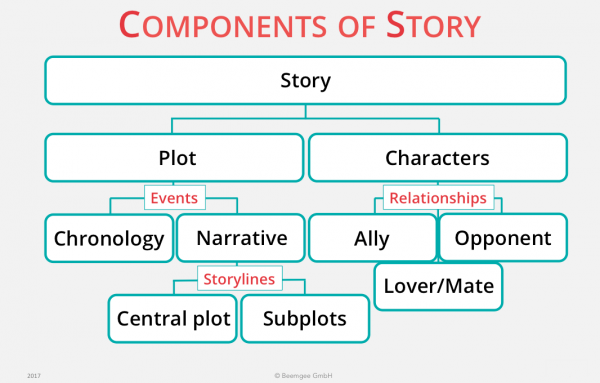Story vs. Narrative
It’s the way you tell it
Narrative is the choice of which events to relate and in what order to relate them – so it is a representation or specific manifestation of the story, rather than the story itself. The easy way to remember the difference between story and narrative is to reshuffle the order of events. A new event order means you have a new narrative of the same story.
Narrative turns story into information, or better, into knowledge for the recipient (the audience or reader). Narrative is therefore responsible for how the recipient perceives the story. The difficulty is that story, like truth, is an illusion created by narrative.
What does that mean?
First, let’s state some basics as we understand them here at Beemgee: a story consists of narrated events; events consist of actions carried out by characters; there is conflict involved; one and the same story may be told in different ways, that is, have varying narratives.
Note that we are talking here about narrative in the dramaturgical sense – not in the social sense. Like the term “storytelling”, the word “narrative” has become a bit of a buzzword. We are not referring here to open “social narratives” such as “the American narrative”. We are pinpointing the use of the term for storytellers creating novels, films, plays, and the like. These tend in their archetypal form to be closed narratives with a beginning, a middle, and an end.
A narrative may present the events of the story in linear, that is to say chronological order or not. But the story remains the story – even if it is told backwards. And that’s the easy way to remember the difference between story and narrative: if you reshuffle the order of events, you are changing the narrative – the way you tell the story –, and perhaps its premise too, but you are not changing the story itself.
The Components of Story

Let’s take “Story” as the hyper-ordinate term. Every story features characters that do something, and the total of these actions constitutes the plot. Plot consists of things that happen, i.e. events. These may be sorted into two different orders, the chronological sequence in time, and the order in which the author chooses to relate them, which is the narrative. A story may furthermore consist of two or several plots – let’s call these storylines – which tend to meet and intertwine.
Click to outline your story in our free web-tool:
Text Types That Describe Story
One and the same story can be represented by different text types:
- Story
- Step Outline
- Treatment
- Exposé
- Logline
All of these may be ascribed to the same work. They are different expressions of the same material.
The logline and the exposé describe the story without telling it, in a sentence or a page respectively.
The treatment is a synopsis of the story – a summary of the plot, including some of the most important events, but not all of them. Such a brief version of the story describes the same story as the full or finished version, but since this short version does not include the same (amount of) events, it is not the (same) narrative.
Both exposé and treatment (and in extreme cases perhaps even the logline) may point out how the narrative works, especially if it is not chronological, but neither actually contains the narrative of the story because neither includes a description of each event.
The step outline describes all the events of the story in narrative order, as a sort of shortened meta-version of the story itself. While a logline, an exposé, a treatment, a step outline, and the finished work may all refer to the same story, only the step outline and the finished work can contain the same narrative of that story because they contain the same events without leaving any out. And as liars know, leaving out bits of information can change the narrative.
The Author Shapes the Material into a Narrative
An author has choices. Many, many choices. An author has to choose the narrative to relate the story she has chosen to tell. For instance, the choice of genre influences the narrative. The same events can be turned into, say, a comedy or a thriller. Stanley Kubrick’s Dr. Strangelove and Sidney Lumet’s Fail-Safe use dissimilar narratives to tell similar stories that make comparable but different points about the threat of nuclear war and how it may come about.
Perhaps the greatest influence on the effect a story has on the audience or reader is the author’s choice of Point of View (PoV). Point of view describes from which character’s perspective the story is told. Hardly any other factor has as significant an effect on narrative. Telling the same story from the various points of view of the participating characters creates differing narratives.
It may thus be argued that story is tantamount to truth in that it ultimately remains equivocal, arguably an illusion created by narrative.
